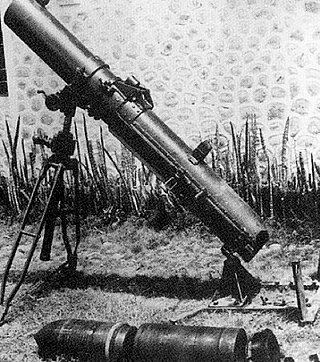Top Qs
Timeline
Chat
Perspective
Type 4 20 cm rocket launcher
Rocket artillery From Wikipedia, the free encyclopedia
Remove ads
The Type 4 20 cm rocket mortar (四式二十糎噴進砲, Yonshiki nijū-senchi funshinhō) was a 203 mm rocket mortar used by the Imperial Japanese Army in the final stages of World War II.
Remove ads
Development and design
Summarize
Perspective
During World War II there was considerable infighting between the Imperial Japanese Army and the Imperial Japanese Navy as both competed for scarce resources. A consequence of this competition is that each produced similar but different weapons.[4] An example of this competition was the Army Type 4 20 cm rocket launcher and the 20 cm Naval Rocket Launcher.[2]
The Type 4 20 cm rocket launcher resembled a conventional mortar, but the barrel had no breech. In order to load the launcher, the lower part of the barrel was lifted open. It was operated by a crew of ten men, 4 of which acted as ammunition carriers.[2] Unlike conventional rocket artillery, the Type 4 was used as a mortar instead of saturation fire.[5][2] It had a sustained rate of fire of 1−2 rockets per minute. The Type 4 warhead had a TNT filling while Ballistite was used as propellant,[1] whose exhaust gasses were forced through six venturis drilled in the base of the rocket which spin-stabilized the projectile.[2] The rocket also used a friction igniter, which dispensed the need of using batteries in the field. It shared fuzes with the Type 100 mortar round which could be either be set for instantaneous or time-delay action.[6]
Although the weapon came with a standard mortar tube with tripod mounting, if necessary, the rocket-propelled round could be launched from an ordinary pipe or culvert with sufficient diameter, wooden rails, or even directly from a slope in the ground.[7]
Studies conducted by the United States Technical Intelligence concluded that the Type 4 20 cm rocket mortar was a "simple, sturdy, mobile device, capable of fine adjustment for accurate fire." While the rocket produced no smoke, it did kick up a cloud of dust during launch and enemy soldiers could hear the approaching rockets in flight.[8]
Remove ads
Operational history
The first units were deployed in 1944, and were used in combat during the Battle of Luzon with the 3rd Rocket Artillery Battalion. Large numbers of Type 4 rockets were kept for use during the projected Allied invasion of the Japanese home islands. According to Ness, 2,900 rockets were delivered by the end of 1944, while another 6,900 were delivered the next year. Production of launchers was estimated at somewhat less than 1,800 units.[5]
According to US Technical Intelligence reports, some rockets were captured in Luzon and subsequently used to a limited degree against their former owners.[9]
Remove ads
Specifications
Users
 Japan − Used by the Imperial Japanese Army
Japan − Used by the Imperial Japanese Army United States − Limited use of captured rockets in the Battle of Luzon[11]
United States − Limited use of captured rockets in the Battle of Luzon[11]
Photo gallery
- A schematic of rocket components.
- A Type 4 rocket launcher in the Yasukuni Shrine.
- A Type 4 launcher opened for loading.
- A Type 4 rocket on a launch ramp.
References
External links
Wikiwand - on
Seamless Wikipedia browsing. On steroids.
Remove ads





